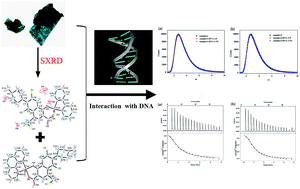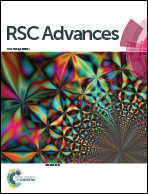Synthesis, structure, and calf-thymus DNA binding of ternary fleroxacin–Cu(ii) complexes†
Abstract
Two mononuclear copper(II) (Cu(II)) complexes containing quinolone drug fleroxacin (flrx) were synthesized in the presence of 1,10-phenanthrolin (phen) and 2,2′-bipyridine (bipy). To fully characterize these two complexes, single-crystal X-ray diffraction study and other characterizations were employed. X-ray crystallography results showed that the deprotonated flrx coordinated with the central Cu(II) via one pyridone oxygen and one carboxylate oxygen. Intermolecular interactions including hydrogen bonding and π–π stacking stabilized these complexes. Moreover, interactions of [Cu(flrx)(bipy)Cl]·4H2O and [Cu(flrx)(phen)·H2O]·9.8H2O complexes with calf-thymus DNA (CT DNA) were investigated. Fluorescence measurements and fluorescence lifetime investigations indicated that CT DNA could effectively quench the fluorescence of the complexes and the interaction modes were static quenching. Isothermal titration calorimetry showed that the two complexes exhibited a similar moderate binding affinity to CT DNA, and their binding constants were basically consistent with the results of the fluorescence measurements. Thermodynamic parameters revealed that the bindings were driven by considerable enhancements in beneficial entropy and unfavorable increases in enthalpy, and the negative Gibbs energy values indicated that the interactions were spontaneous. Circular dichroism, interaction with denatured CT DNA, and iodide quenching studies suggested that the possible interaction modes between CT DNA and these two complexes are both in the intercalation mode.


 Please wait while we load your content...
Please wait while we load your content...